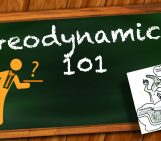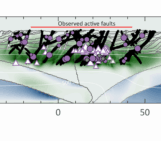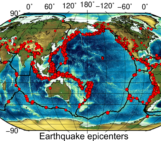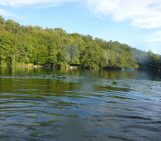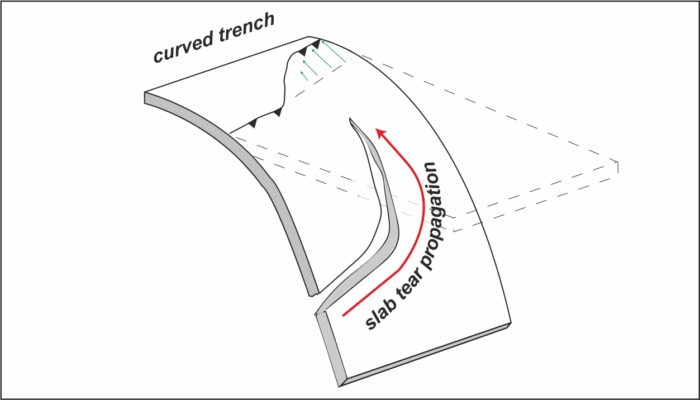

TT Prof. Dr. Nevena Andrić-Tomašević, Institute of Applied Geosciences, Karlsruhe Institute of Technology (KIT), Germany
Slab tearing refers to the gradual propagation of the break-off of a subducting plate. As observed in numerous modern and ancient convergent tectonic settings, the growth of the tear “window” in the downgoing plate has strongly influenced various geologic and geodynamic processes, such as depocenter migration of foreland basins, uplift rates in mountain ranges, earthquakes, volcanism, and flow patterns in the upper mantle. However, our understanding of the dynamics of slab break-off and tearing, especially in non-collisional environments, is still limited. This week, Nevena Andrić-Tomašević, Tenure-track Professor at the Institute of Applied Geosciences, Karlsruhe Institute of Technology (KIT), and Alexander Koptev, a postdoctoral researcher at the German Research Centre for Geosciences (GFZ Potsdam), report on their recent work on slab tearing in the context of oblique oceanic subduction. (Andrić-Tomašević et al., 2023).
The concept of slab tearing emerged several decades ago from seismic topography models of the 3D velocity structure of the upper mantle in the Mediterranean-Carpathian region as an explanation for detached fragments of subducting plate in the upper and lower mantle (Spakman, 1990; Wortel and Spakman, 1992, 2000; Hafkenscheid et al., 2006). The slab tearing is thus considered as lateral or vertical propagation of rupture in the subducting slab, producing a gap (or “window”) in the downgoing lithosphere whose gradual growth (or “opening”) significantly affects mantle flow patterns (e.g., Govers and Wortel, 2005; Duretz et al., 2014). Other consequences include thermal perturbations, anomalous magmatic activity, acceleration of trench retreat and rotation, and extension within overriding plate (e.g., Rosenbaum et al., 2008; Burkett and Billen, 2010; Menant et al., 2016).

Dr. Alexander Koptev, postdoctoral researcher at the German Research Centre for Geosciences (GFZ Potsdam)
The first 3D thermo-mechanical models of slab break-off (Burkett and Billen, 2010; van Hunen and Allen, 2011) have demonstrated that in the case of a laterally symmetric and homogeneous subducting plate, detachment occurs almost simultaneously along the entire length of the slab. In contrast, the presence of lateral heterogeneities in the incoming subducting plate (mid-ocean ridges or continental blocks) leads to horizontally propagating rupture of the slab (or slab tearing). Inspired by these findings, subsequent modelling studies (Li et al., 2013; Duretz et al., 2014; Sternai et al., 2014; Menant et al., 2016) explored the dynamics of the continental corner (i.e., the lateral transition between continents and oceans) during simultaneous oceanic subduction and continental collision and showed that the subducting plate first detaches beneath the collided continents and then propagates toward the adjacent region of continuous ocean-continent subduction. Combined with geodynamic and geologic data and reconstructions, numerical modelling has revealed that heterogeneities within the incoming oceanic lithosphere, such as along strike variable slab ages, asymmetric mantle flow in oblique subduction settings or the arrival of terranes (e.g., oceanic plateaus, island arcs, seamounts, submarine ridges, continental fragments), can not only result in variable roll-back velocities along the active margin (e.g., Balazs et al., 2021) but also appear to be the main factor controlling the process of slab tearing (e.g., Rosenbaum et al., 2008).
Although tomographic imaging has captured slab tearing in numerous subduction zones worldwide, such as Izu-Bonin-Marianas (Stern et al., 2004; Miller et al., 2006; Zhang et al., 2019), Tonga (Bevis et al., 1995; Martin, 2014), Mexico (Rogers et al., 2002), and Sunda (Curray, 1989; Widiyantoro and van der Hilst, 1996), the process of slab rupture has not yet been investigated in non-collisional settings with continuous ocean-continent or ocean-ocean subduction. Here, we focus our modeling study on examining the effects of subduction obliquity on the dynamics of slab break-off and tearing. To do so, we have performed a series of 3D thermo-mechanical experiments for oblique subduction (i.e., subduction where the convergence vector and trench are not perpendicular to each other) using the viscous-plastic code I3ELVIS (Gerya and Yuen, 2007; Gerya, 2019). In our work, we analyzed the impact of three key parameters: (1) subduction obliquity angle, (2) age of the oceanic slab, and (3) partitioning of boundary velocities (i.e., the ratio between subduction component and overriding plate advance in the overall convergence).
In our simulations, we find that as the subducting slab retreats, the fore-arc and back-arc lithosphere becomes thinner because the hot asthenosphere rises from the underlying mantle wedge, decoupling the overriding plate from the subducting slab. As a result of the initial obliquity of the active plate margin, the velocity of the slab roll-back varies progressively along the trench. Coevally with the gradual rotation of the trench, the decoupling front between the overriding and downgoing plates, along with predicted magmatic activity and topographic uplift, migrates in a horizontal direction.
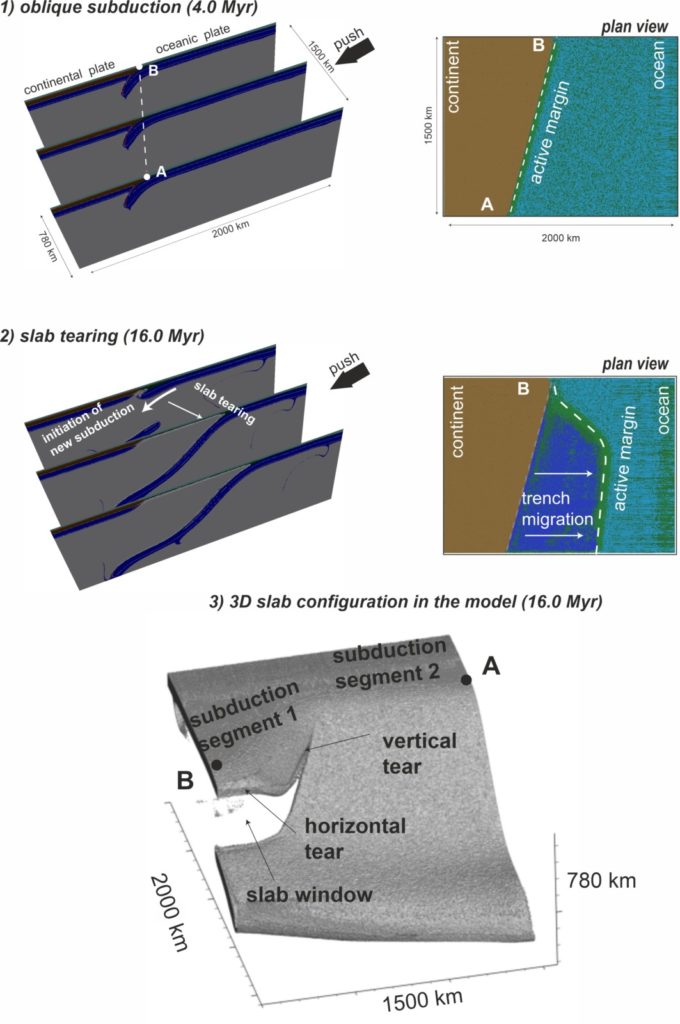
Figure. 1) Compositional field of the initial model setup with oblique subduction. Both cross (left panel) and plan views (right panel) are shown. 2) The breakoff initiates first in the back side of the model domain and propagates (i.e., tearing) towards frontal side. The tearing is associated with differential trench retreat velocities causing counter clockwise trench rotation. 3) 3D configuration of the subducting plate showing the slab window resulting from progressive horizontal tear propagation transforming into vertical tearing.
Our models indicate that in subduction zones with low angles of subduction obliquity (< 15◦), relatively old subducting plates (> 50 Ma), and in the absence of the subduction component in the total shortening, slab detachment occurs either simultaneously along the entire length of the subduction zone or not at all. In contrast, with higher subduction obliquity (≥ 15◦), younger slabs (≤ 50 Ma), and in the presence of a boundary push on the oceanic side, the initial slab break-off is followed by the gradual growth of the tear “window” in the direction opposite to the migration path of the previously established plates decoupling. The sharp contrast in trench retreat rates between subduction zone segments affected and unaffected by slab detachment results in the arcuate shape of the trench (Fig. 1. 1-2). Furthermore, the direction of slab tearing may change from horizontal to vertical, eventually leading to the formation of a transform fault on the subducting plate (Fig. 1. 3).
In contrast to previous studies (Burkett and Billen, 2010; Li et al., 2013; Cui and Li, 2022), we show for the first time that even with a homogeneous oceanic plate and laterally unchanging constant boundary velocities, the obliquity of the active margin appears to be a sufficient factor to cause horizontal and vertical slab tearing. Remarkably, our results demonstrate striking similarities with several characteristic features, such as trench curvature, subduction zone segmentation, magmatic production, lithospheric stress/deformation fields, and associated topographic changes, observed in many real-world subduction zones (e.g., Marianas, New Hebrides, Mexico, and Calabrian). Therefore, our modelling may provide valuable insights to explain arcuate trench configurations and segmented subduction boundaries on length scales up to 1500 km. In addition, we reveal that horizontal and vertical slab tearing are temporally and spatially coupled processes that represent district phases in the dynamic evolution of the lithosphere-mantle system.
References: Andrić-Tomašević, N., Koptev, A., Maiti, G., Gerya, T., & Ehlers, T. A. (2023). Slab tearing in non-collisional settings: Insights from thermo-mechanical modelling of oblique subduction. Earth and Planetary Science Letters, 610. https://doi.org/10.1016/j.epsl.2023.118097 Balázs, A., Faccenna, C., Ueda, K., Funiciello, F., Boutoux, A., Blanc, E.J.-P., Gerya, T., 2021. Oblique subduction and mantle flow control on upper plate deformation: 3D geodynamic modeling. Earth Planet. Sci. Lett. 569, 117056. Bevis, M., et al., 1995. Geodetic observations of very rapid convergence and back-arc extension at the Tonga arc. Nature 374 (6519), 249–251. Burkett, E.R., Billen, M.I., 2010. Three-dimensionality of slab detachment due to ridge-trench collision: laterally simultaneous boudinage versus tear propagation. Geochem. Geophys. Geosyst. 11 (11), Q11012. Cui, Q., Li, Z.H., 2022. Along-strike variation of convergence rate and pre-existing weakness contribute to Indian slab tearing beneath Tibetan Plateau. Geophys. Res. Lett. 49 (4), e2022GL098019. Curray, J.R., 1989. The Sunda Arc: a model for oblique plate convergence. Neth. J. Sea Res. 24 (2–3), 131–140 Duretz, T., Gerya, T.V., Spakman, W., 2014. Slab detachment in laterally varying subduction zones: 3-D numerical modeling. Geophys. Res. Lett. 41, 1951–1956. https://doi.org/10.1002/2014GL059472. Gerya, T., 2019. Introduction to Numerical Geodynamic Modelling, 2nd edition. Cambridge University Press, p. 471 Gerya, T.V., Yuen, D.A., 2007. Robust characteristics method for modelling multiphase visco-elasto-plastic thermo-mechanical problems. Phys. Earth Planet. Inter. 163 (1–4), 83–105. https://doi.org/10.1016/j.pepi.2007.04.015. Govers, R., Wortel, M.J.R., 2005. Lithosphere tearing at STEP faults: response to edges of subduction zones. Earth Planet. Sci. Lett. 236 (1–2), 505–523. https://doi.org/10.1016/j.epsl.2005.03.022 Hafkenscheid, E., Wortel, M.J.R., Spakman, W., 2006. Subduction history of the Tethyan region derived from seismic tomography and tectonic reconstructions. J. Geophys. Res., Solid Earth 111 (B8), B08401 Li, Z.H., Xu, Z., Gerya, T., Burg, J.P., 2013. Collision of continental corner from 3-D numerical modeling. Earth Planet. Sci. Lett. 380, 98–111. Martin, A.K., 2014. Concave slab out board of the Tonga subduction zone caused by opposite toroidal flows under the North Fiji Basin. Tectonophysics 622, 56–61. Menant, A., Sternai, P., Jolivet, L., Guillou-Frottier, L., Gerya, T., 2016. 3D numerical modeling of mantle flow, crustal dynamics and magma genesis associated with slab roll-back and tearing: the eastern Mediterranean case. Earth Planet. Sci. Lett. 442, 93–107. Miller, M.S., Kennett, B.L.N., Toy, V.G., 2006. Spatial and temporal evolution of the subducting Pacific plate structure along the western Pacific margin. J. Geophys. Res. 111, B02401. https://doi.org/10.1029/2005JB003705 Rogers, R., Karason, H., van der Hilst, R., 2002. Epeirogenic uplift above a detached slab in northern Central America. Geology 30, 1031–1034. Stern, R.J., Fouch, M.J., Klemperer, S.L., 2004. An overview of the Izu-Bonin-Mariana subduction factory. In: Eiler, J. (Ed.), Inside the Subduction Factory. Sternai, P., Jolivet, L., Menant, A., Gerya, T., 2014. Driving the upper plate surface deformation by slab rollback and mantle flow. Earth Planet. Sci. Lett. 405, 110–118. Van Hunen, J., Allen, M.B., 2011. Continental collision and slab break-off: a comparison of 3-D numerical models with observations. Earth Planet. Sci. Lett. 302, 27–37 Widiyantoro, S., van der Hilst, R., 1996. Structure and evolution of lithospheric slab beneath the Sunda arc, Indonesia. Science 271 (5255), 1566–1570. Wortel, M.J.R., Spakman, W., 2000. Geophysics – subduction and slab detachment in the Mediterranean-Carpathian region. Science 290 (5498), 1910–1917. Zhang, H., Wang, F., Myhill, R., et al., 2019. Slab morphology and deformation beneath Izu-Bonin. Nat. Commun. 10, 1310. https://doi.org/10.1038/s41467-019-09279-7.

